|
|
|
Sort Order |
|
|
|
Items / Page
|
|
|
|
|
|
|
| Srl | Item |
| 1 |
ID:
114581
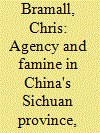

|
|
|
|
|
| Publication |
2011.
|
| Summary/Abstract |
A revisionist literature on the Great Chinese Famine has emerged in recent years. These revisionists focus primarily on the question of agency. They claim that that neither poor weather nor the excesses of local cadres can explain the extent of mortality; rather, responsibility lies squarely with Mao and the CCP leadership. Using county-level data on mortality, output, rainfall and temperature for Sichuan province, I argue that this revisionist view is unconvincing. Weather admittedly played only a minor role, and the zealotry of the Party centre contributed significantly to the death toll. However, variations in mortality between Sichuan's counties appear to have been essentially random - suggesting that differences in local cadre responses to central government policy were decisive in determining the scale of famine.
|
|
|
|
|
|
|
|
|
|
|
|
|
|
|
|
| 2 |
ID:
116202
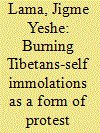

|
|
|
| 3 |
ID:
179283


|
|
|
|
|
| Summary/Abstract |
Situated far from coastal cities and foreign concessions, Chengdu yields insights into the role of the local press and its specific publics in the political evolution of the late Qing and early Republic. Despite its remote location, Chengdu developed its own modern press in the late Qing, relying on print entrepreneurs and modern journalists recruited from the ranks of the local literati and traditional sociability, in particular teahouses. They all played a role in forming a modern reading public which came to understand itself as a distinct local political community in dynamic interaction with national politics and transnational networks. The local press evinced three successive but intertwined ideals of publicness: as a link between the state and the people and a vector of enlightenment, as a professional forum for public opinion and as a tool for political mobilization. In solidifying public opinion around the local community, the press served as a forum and catalyst for political activism in the 1911 Railroad Protection movement and the 1919 May Fourth movement, events which were shaped as much by local dynamics as they were by national developments.
|
|
|
|
|
|
|
|
|
|
|
|
|
|
|
|
| 4 |
ID:
038712
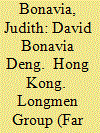

|
|
|
|
|
| Publication |
Hong Kong, Longmen Group (Far East) Ltd, 1989.
|
| Description |
xiii, 268p.Hbk
|
| Standard Number |
0582999529
|
|
|
|
|
|
|
|
|
|
|
|
Copies: C:1/I:0,R:0,Q:0
Circulation
| Accession# | Call# | Current Location | Status | Policy | Location |
| 032115 | 923.251/BON 032115 | Main | On Shelf | General | |
|
|
|
|
| 5 |
ID:
172252
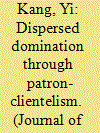

|
|
|
|
|
| Summary/Abstract |
This study is based on 10 years of ethnography research in six cities in Sichuan after the Wenchuan earthquake. The author delineates local officials’ dispersed clientelist endeavours seeking stable collaboration with NGOs. In contrast to the corporatism model, in which government control of NGOs is formal and from the top down, the patron–client relationship entails considerably more subjectivity, flexibility and dispersion in the exercise of state power, which may or may not result in effective implementation of the state’s policy objectives. As local government officials increasingly deploy their informal authority in addition to their extensive institutional power, and as informal networks lubricate the policy process, state dominance over society becomes more pervasive, entrenched and fragmented.
|
|
|
|
|
|
|
|
|
|
|
|
|
|
|
|
| 6 |
ID:
102127
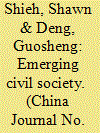

|
|
|
| 7 |
ID:
132947
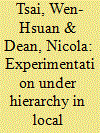

|
|
|
|
|
| Publication |
2014.
|
| Summary/Abstract |
Reforms carried out by the Chinese Communist Party (CCP) have long followed a traditional model of "experimentation under hierarchy." This article will attempt to develop this model further by building a framework to illustrate the influence of both the political dynamics of hierarchical central-local relations and local economic circumstances in the introduction of large-scale political reforms. The initiation and expansion of "experimental points" are only permitted in those select few provinces with both favourable political and economic local conditions, allowing the CCP to minimize risk and make informed decisions regarding possibilities for nationwide reform. This article proposes that the hierarchical interaction of central and local political elites, and in particular provincial secretaries, can explain the extent of reforms, whereas the type of reform is linked to distinct provincial economic conditions and the provincial secretary's interpretation of provincial priorities. Put succinctly, the CCP's model of political reform can be specifically characterized as "experimentation under hierarchy in local conditions." This article presents a detailed discussion of both the political and economic considerations inherent in this concept, and provides examples of reform programmes in Guangdong and Sichuan to illustrate the model in practice.
|
|
|
|
|
|
|
|
|
|
|
|
|
|
|
|
| 8 |
ID:
137363
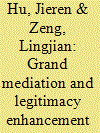

|
|
|
|
|
| Summary/Abstract |
China has seen numerous instances of collective resistance in recent years. Suppression cannot stop popular resistance. It is also hard to solve all problems through the existing judicial system, administrative method or by social means. Based on a case study in Sichuan, this article studies the Grand Mediation (GM) mechanism in Guang'an as one of the ways in which the Chinese government chooses to build institutions and channel social grievances. GM is successful in containing social conflicts and helping the state to garner legitimacy by reducing people's hostility towards local government, which could enhance the CCP's legitimacy, whose paramount goal is to maintain political stability and social harmony.
|
|
|
|
|
|
|
|
|
|
|
|
|
|
|
|
| 9 |
ID:
121204
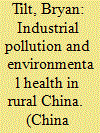

|
|
|
|
|
| Publication |
2013.
|
| Summary/Abstract |
After more than three decades of extremely rapid industrial growth, China faces an environmental public health crisis. In this article, I examine pollution in the rural industrial sector and its implications for community health. Drawing on recent ethnographic research in an industrial township in rural Sichuan, including interviews with government officials, environmental regulators, industrial workers and local residents, I explore how community members understand the linkages between air and water pollution from nearby factories and their health and well-being. The article has two main goals. The first is to examine the various ways in which uncertainty about pollution sources, about the severity of pollution levels and about the links between pollution and human health shapes villagers' experiences of pollution on a day-to-day basis. The second goal is to examine the rising trend of "individualization" taking place in China today and explore how this process is related to people's experiences of toxic exposure. I consider the implications of this trend for how social scientists should approach the study of environmental illness in contemporary China.
|
|
|
|
|
|
|
|
|
|
|
|
|
|
|
|
| 10 |
ID:
192623
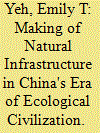

|
|
|
|
|
| Summary/Abstract |
Campaign-style environmental enforcement that involves the destruction of infrastructure has become increasingly common. Scholars have theorized such crackdowns as a form of bureaucratic control. These explanations are compelling, yet incomplete. This paper adopts an infrastructural lens to call attention to the fact of infrastructural demolition. I argue that the reduction of existing infrastructure to rubble is a way of clearing space for other kinds of infrastructure, specifically natural infrastructure, which has become central in the pursuit of ecological civilization. The creation of natural infrastructure requires calculative tools, which work to obscure the profoundly political nature of the natural infrastructure that they create through spatial zoning, ecological functional zoning and ecological conservation red lines (ECRLs). The article then scales down to two case studies of villages in post-earthquake Sichuan that are within ECRLs and designated for the function of providing ecosystem services. In both, infrastructure within scenic areas that was previously encouraged by the state and central to village livelihoods was suddenly destroyed following ecological civilization enforcement campaigns. The arrival of natural infrastructure marks a national-scale infrastructural time that promises a new future in which village-controlled scenic areas have no part, leading to a ruination of their imagined futures.
|
|
|
|
|
|
|
|
|
|
|
|
|
|
|
|
| 11 |
ID:
110016
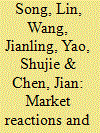

|
|
|
|
|
| Publication |
2012.
|
| Summary/Abstract |
This paper studies the market reactions to corporate philanthropic giving in response to the 12 May 2008 Wenchuan earthquake in Sichuan, China. Based on a sample of 136 Chinese listed companies, our results indicate a significant and positive seven-day cumulative abnormal rise in the share prices of those companies making donations compared to those not making donations. Both timeliness and the amount of philanthropic giving generate significant market reactions, confirming Godfrey's assertion that corporate philanthropy can be perceived as a genuine manifestation of firms' underlying desire to raise their market values. However, when the sample firms are divided into two groups, government controlled and non-government controlled, Godfrey's assertion is challenged by our empirical results which show different market responses to the two different types of companies.
|
|
|
|
|
|
|
|
|
|
|
|
|
|
|
|
| 12 |
ID:
053777
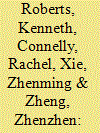

|
|
|
| 13 |
ID:
106752
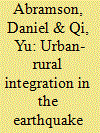

|
|
|
|
|
| Publication |
2011.
|
| Summary/Abstract |
One of the more recent movements in China's policy for periurban planning and development is the pursuit of "town and country integration" (cheng xiang yi ti hua). The officially reframed approach to planning suggests possibilities for the official reconsideration of developmental practice, but entrenched conditions of governance, land, environmental and developmental policy, and the planning profession itself constrain these possibilities. Perhaps no other context in China illustrates these constraints more dramatically than the reconstruction effort underway in Sichuan following the earthquake of May 12, 2008. Cultural, environmental and economic differences among settlements in the earthquake zone vary widely, and local and national leaders frequently mention the opportunity the recovery presents for innovative and sustainable development, but the "cataclysmic" nature of reconstruction investment, and the extremely rapid and construction-dominated approach to recovery has prevented planners from considering local conditions or alternative approaches. If the official earthquake response has served to propel urbanization along preexisting trajectories, local geographical, historical and cultural conditions nevertheless assert themselves, even if informally. The uniquely dense, dispersed and agriculturally productive Chengdu Plain has already shaped a national discourse on urban-rural relations. The expansion of Chengdu's urban region into the narrow valleys and minority ethnic settlements across the Longmen Mountains presents new and unpredictable challenges for considering how city and country are related.
|
|
|
|
|
|
|
|
|
|
|
|
|
|
|
|
|
|
|
|
|